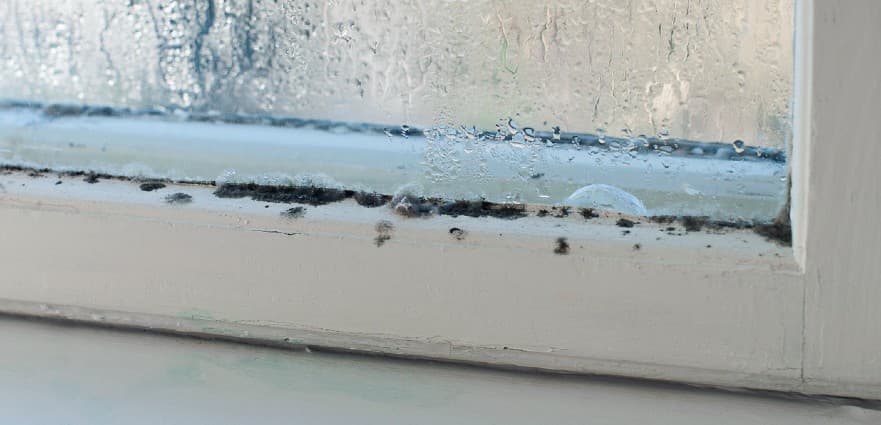Sitting water will eventually be detrimental to any surface it collects on, even waterproof surfaces. Think limescale build-up and mould.
While uPVC windows are built to withstand water, excessively wet seals combined with strong direct sunlight can cause them to dry and crack from constant expansion and contraction.

The main concern from standing water and moisture is mould. If left untreated mould will damage and discolour uPVC and wood.
More importantly, mould is exceptionally bad for our health.
Condensation and black mould
The real issue with condensation is that it can lead to black mould.
Patches of black mould around windows, on doors and on walls doesn’t just look unsightly, it could be making you seriously ill.
The main symptoms from mould are:
- Stuffy nose
- Wheezing
- Red or itchy eyes
- Skin rashes and itching
WHO also reports that mould can contribute to:
- Asthma
- Allergic rhinitis
- Hypersensitivity pneumonitis
- Allergic alveolitis
- Chronic rhinosinusitis
- Allergic fungal sinusitis.
There is more (non proven) evidence that acute idiopathic pulmonary haemorrhage causes memory loss and lethargy for infants.
Undoubtedly, mould is bad news and needs to be dealt with.
Any mould that appears should be carefully cleaned and removed and then preventative measures put in place to get rid of condensation.
How to stop condensation on windows
The main cause of condensation is a lack of ventilation. The remedy is to improve ventilation to help equalise humidity inside and outside a property.
Once upon a time, houses had badly-fitted windows, doors, chimneys and air vents that allowed for the circulation of air.
Homes have become considerably more energy-efficient over the last thirty years and this has resulted in a lot of houses becoming sealed units that trap moisture in the house.
Although we have become better at retaining heat, we have lost natural ventilation in our homes.
Getting rid of condensation on windows for good will involve:
- Improving ventilation
- Reducing moisture
- Installing double or triple glazed windows
How to improve ventilation to reduce condensation
There are a few options to improve ventilation in your home:
Airflow system
Many new apartments are built with internal airflow systems to combat the problem. These systems use a network of ducts in the ceiling to extract and exchange air from the outside to inside.
This maintains air circulation and a humidity balance within a property that is well-sealed.
Retrofitting a ventilation system in a house is invasive and expensive and not always possible in older houses.
PIV Unit
For an easier to install solution, Positive Input Ventilation (PIV) units can be fitted in areas that produce excessive moisture. Such as kitchens and damp basements.
The unit extracts the humid air from inside the house and draws in ‘dry’ air from the outside. This exchange of air helps to maintain the humidity balance.
Extractor fan
Having sufficient extraction in a bathroom is essential to reduce the excessive humidity produced from showers. Some fans have humidity control and will allow the fan to operate automatically if the humidity level increases above a set level.
Kitchens also need good extraction systems for cooking to remove smoke, smells and moisture.
Air vents/bricks
Air bricks often get blocked to stop draughts, but they do work to keep an area ventilated. A simple vent will ensure the humidity is managed in a room, but this does have the result of energy efficiency being reduced. For this reason, air bricks are not as popular as they used to be.
Air vents in windows do work to help with ventilation and stop condensation on the window. They can be installed on most windows.
Opening windows
Your grandmother probably used to open the doors and windows every morning to ‘air’ her home. There is nothing better than allowing fresh air to circulate through a space to keep it ventilated, remove stale air and smells and to reduce moisture in the house.
Traditional windows were used to provide effective ventilation which was essential when most homes were heated by fossil fuels.
Sash windows were designed to allow for the bottom and top to be opened that would draw air in and out providing effective ventilation.
Bay windows were designed to have two casement windows on either side to allow superior draw and ventilation.
Transom windows above a door were designed to increase airflow around a property to move heat around internally and to ventilate.
Modern windows all have multi-point lock settings to allow them to be left open securely for ventilation. This is one of the simplest and easiest ways to keep your home ventilated and avoid condensation.
Reducing moisture to reduce condensation
In combination with ventilation, reducing moisture is also essential to stop condensation. The average household produces a considerable amount of water vapour each day just from normal living activities.
| Cooking | Up to 3 litres per day |
| Clothes washing | 0.5 litres per wash |
| Showers and baths | 1.5 litres per person |
| Washing dishes Up to | 1 litre per day |
| Un-vented clothes drying | 5.0 litres per load |
| Breathing, active adult | 0.2 litres an hour per person |
| Breathing, adult asleep | 0.02 litres an hour per person |
Houseplants and pets also contribute to water moisture in the air and condensation.
The biggest causes of excess moisture that causes condensation
All of these areas should be addressed to try and minimise the impact they have on contributing to humidity in the house:
- Cooking, boiling pans and kettles
- Showers and hot taps
- Washing machines and tumble dryers
- Drying clothing on radiators or indoor airers
- Large houseplants
- Wet logs stored for wood burners
- Unfound water leaks in cavities or under floors
- Rising damp in basements and ground-level buildings